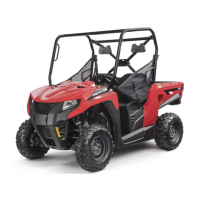20
NOTE: The high range is for nor-
mal driving with light loads. The low
range is for carrying heavy loads or
trailer towing. Compared to HIGH
range, the LOW range position pro-
vides slower speed and greater
torque to the wheels.
5. To select park, move the shift lever
completely down until the letter “P”
is displayed on the LCD gauge.
Driving the Vehicle
Once the engine is warm, the vehicle is
ready to be driven.
1. With the engine idling, press the foot
brake pedal to apply the brake; then
select the appropriate operating range
and/or direction with the shift lever.
2. Release the foot brake pedal and
press the accelerator to slowly add
power to start moving.
3. To slow down or stop, release the
accelerator and press the foot brake
pedal as necessary to slow or stop
the vehicle.
Braking/Stopping
Always allow plenty of room and time to
stop smoothly. Sometimes quick stops
are inevitable, so always be prepared.
Whether you’re stopping slowly or stop-
ping quickly, do this:
1. Release the accelerator; then press
the foot brake pedal to apply the
brake.
2. If the wheels lock, release them for a
second; then apply them again. On
surfaces such as ice, mud, or loose
gravel, pump the brake pedal rapidly.
3. Never “ride” the brake. Even main-
taining minimal pressure on the
brake pedal will cause the brake
pads to drag on the disc and may
overheat the brake fluid.
Parking
Parking involves following the previous
rules for braking; then:
1. After the vehicle stops, shift into
park.
2. Turn off the ignition.
3. If you have to park on a hill, block
the wheels on the downhill side.
Basic Turns
Steering effort is at its lowest in two-
wheel drive (2WD). Greater effort is
needed when in four-wheel drive (4WD).
The greatest effort is needed when in
four-wheel drive and the differential (if
equipped) is locked.
Slow down before entering a turn. The
basic turning technique is to drive at low
speed and gradually adjust the amount of
steering to suit the driving surface. Do
not make sudden sharp turns on any sur-
face. Refer to the sub-sections Driving
Uphill, Driving Downhill, Crossing
Obstacles, Driving in Reverse, Skidding
or Sliding, Crossing Water, or Crossing
Roads for more information.
If your vehicle ever skids sideways
during a turn, steer in the direction of the
skid. Also, avoid hard braking or acceler-
ating until you have regained directional
control.
CAUTION
Always shift into low range when
operating on wet or uneven terrain,
when towing or pushing heavy loads,
and when using a plow. Failure to fol-
low this caution may result in prema-
ture V-belt failure or in damage to
related drive system components.
CAUTION
Never increase engine speed above
idle RPM when in park or belt damage
will occur.
! WARNING
Excessive repetitive use of the
hydraulic brake for high speed stops
will cause overheating of the brake
fluid and premature brake pad wear
which will result in an unexpected
loss of brakes.
! WARNING
Use only approved brake fluid. Never
substitute or mix different types or
grades of brake fluid. Brake loss can
result. Check brake fluid level and pad
wear before each use. Brake loss can
result in serious injury or death.

